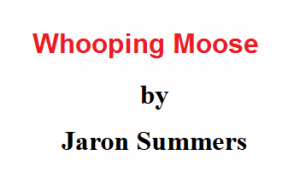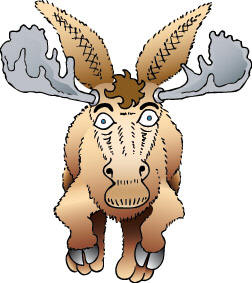Watch the two-minute film: Ten years ago, Dr. Erve, one of the world’s leading environmentalists, led a worldwide drive to save Canada’s whooping moose from extinction.

The miniature moose, about the size of a rabbit, makes a sound similar to the whooping crane. There were forty-three of the small quadrupeds left on the planet.
Dr. Erve established the Dr. Erve Whooping Moose Reserve near Banff. No one really knew what the tiny animals fed on and I asked Dr. Erve about this.
“It was quite simple. Pine needles. The little fellows thrive on pine needles. A whooping moose will eat up to 10 percent of its weight in pine needles daily. Millions of metric tons of pine needles are in my reserve.”
“Ah, I imagine you analyzed their droppings to find out what they ate.”
“Wasn’t time to deploy teams to collect scats. Creatures were only a heartbeat away from total extinction.”
“So how’d you find out what they fed on?”
“We shot them,” said Dr. Erve.
“With tranquilizers? I asked.
“No point to that,” said the professor. “We knew we’d have to cut open their stomachs, so we used shotguns with number five pellets. Bloody lethal, ‘eh?”
“You killed them?” I asked.
“Yes, still had a slight problem. The blast from our shotguns would slam, actually spray, the whooping moose into pine trees.”
“Quite frankly, we were never certain if the pine needles were inside them or if our field research made it look like they had fed on pine needles. No alternative but cyanide.”
“Good grief!”
“We learned that whooping moose fed in groups. We thought we were only going to poison two or three but since the little guys are so darn gregarious, we culled more specimens than we bargained for. Quite a revelation about their eating habits. A real feather in my cap.”
“How many whooping moose did you poison?”
“We tried for several, but we ended up with ten excellent specimens.”
“And that’s how you found out what they ate?”
“No, sadly, the cyanide changed the composition of their stomach contents. Had to start all over. Back to square one.”
“Rotten luck,” I said.
“Don’t believe in luck. Believe in science. We brought in a crack team of Yukon hunters and they caught the buggers in traps. Now before we hear from animal rights groups, I want everyone to realize we used special quick-kill traps that broke the necks of the whooping moose instantly.”
“No painful leg holds.”
“Snap! We had our specimens.”
“It is from those specimens that we managed to prove beyond any doubt that millions of whooping moose could thrive in the special area we set aside for them.”
“But there was a problem….”
The old naturalist sighed. “The females, or sows as they are known, are cunning. Wouldn’t go near the traps.”
“And?”
“We trapped all the males. Species won’t be able to reproduce next spring. Ironic after we did so much for them.”




